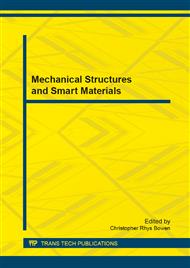[1]
Fang F Z, Liu Y C. On minimum exit-burr in micro cutting [J]. Journal of Micromechamics and Microengineering, 2004, 14: 984-988.
DOI: 10.1088/0960-1317/14/7/020
Google Scholar
[2]
Chern G L, Dornfeld D. Burr/breakout model development and experimental verification [J]. Journal of Engineering Materials and Technology, 1996, 118(2): 201-207.
DOI: 10.1115/1.2804887
Google Scholar
[3]
Schmidt J, Tritschler H. Micro cutting of steel [J]. Microsystem Technologies, 2004(10): 167-174.
DOI: 10.1007/s00542-003-0346-3
Google Scholar
[4]
Kishimoto W, Miyake T, Yamamoto A. Study of burr formation in face milling [J]. Bull. Jap. Soc. Precision Engng, 1981(15): 51-52.
Google Scholar
[5]
Nakayama K, Arai M. Burr formation in metal cutting [J]. College Institute Research Production Annals, 1987(1): 33-36.
Google Scholar
[6]
Damazo B N, Davies M A. A summary of micro-milling studies [C]/Initiatives of Precision Engineering at the Beginning of a Millennium. United States of America: Kluwer Academic Publishers, 1999: 322-324.
Google Scholar
[7]
Schaller T, Bohn L. Microstructure grooves with a width of less than 50μm cut with ground hard metal micro end mills [J]. Precision Engineering, 1999(23): 229-235.
DOI: 10.1016/s0141-6359(99)00011-2
Google Scholar
[8]
Lee K, Dornfeld D A. An experimental study on burr formation in micro milling aluminum and copper [J]. Transactions of the North American Manufacturing Research Institute of SME, 2002, 30: 255-262.
Google Scholar
[9]
Lee K, Dornfeld D A. Micro-burr formation and minimization through process control [J]. Precision Engineering, 2005(29): 246-252.
DOI: 10.1016/j.precisioneng.2004.09.002
Google Scholar
[10]
Le D, Lee J M. Burr analysis in microgrooving [J]. Int J Adv Manuf Technol, 2010, 50: 569-577.
DOI: 10.1007/s00170-010-2516-7
Google Scholar
[11]
Sun YaZhou, Zhang QingChun. Micromilling burr formation research [J]. Modern Manufacturing Engineering, 2006(4): 69-72.
Google Scholar
[12]
SUN YaZhou, ZHANG QingChun. Study on burr formation in micro-milling [J]. Modern Manufacturing Engineering, 2006(4): 69-72(In Chinese).
Google Scholar
[13]
Yang Kai, Bai Qingshun. The simulation and experimental analysis of micro-burr formation mechanism in micromilling process[J]. Nanotechnology and Precision Engineering, 2010, 8(1): 75-83.
Google Scholar
[14]
YANG Kai, BAI QingShun. Modelling and experimental analysis of the mechanism of micro-burr formation in micro-end-milling process [J]. Nanotechnology and Precision Engineering, 2010, 8(1): 75-83(In Chinese).
Google Scholar
[15]
Lai X M, Li H T, Li C F. Modelling and analysis of micro scale milling considering size effect, micro cutter edge radius and minimum chip thickness [J]. International Journal of Machine Tools & Manufacture,2008(48): 1-14.
DOI: 10.1016/j.ijmachtools.2007.08.011
Google Scholar
[16]
Melkote S N. Evidence of ductile tearing ahead of the cutting tool and modeling the energy consumed in material separation in micro-cutting [J]. Journal of Engineering Materials and Technology, 2007, 129(321): 321-331.
DOI: 10.1115/1.2712471
Google Scholar


